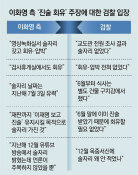Beef Market Grows, Pork and Chicken Market Shrinks
Beef Market Grows, Pork and Chicken Market Shrinks
Posted July. 24, 2007 03:02,
The import of American beef has resumed after the embargo on beef products initiated as a result of mad cow disease three and a half years ago. Contrary to expectations, the resumption of beef import hasnt reduced the sales of Korean and Australian beef; in fact, more Korean and Australian beef is selling than before.
However, the consumption of pork and chicken, substitutes for beef, is decreasing. This means that the share of beef in the domestic meat market has increased after resuming U.S. beef import. And analysts think that consumers are enjoying the benefits of the resumption.
Growing Market Share of Beef-
Lotte Mart was the first among big retailers to sell U.S. beef. From July 13 to July 22, the retailer sold 100 tons of beef.
Some predicted that the sales of Australian beef could suffer the most serious damage by the resumption of the import. But during the same time, 62 tons of Australian beef were sold, a 3.3 percent increase compared to the sales from the same period last year (60 tons).
Korean beef producers sold 45 tons during the same period in 2006 and 2007. As Korean beef is more expensive than imported beef, the sales result relieved domestic producers who feared the loss of sales.
But pork sales have dropped from 280 tons in 2006 to 250 tons in 2007 during the same time. Chicken sales also suffered a 7.9 percent decrease from 380,000 heads to 350,000 heads.
Yoo Ji-hoon is in charge of imported beef at Lotte Mart. He said, Imported beef and domestic beef have different consumer brackets as the price gap is large. Pork and chicken are the substitutes for imported beef, which means consumers can choose between them according to the price.
There are two different explanations for the increased sales of Australian beef. The first is that the imported beef market has expanded. The second is that consumers bought Australian beef instead of U.S. beef when it was sold out, as we have imported only a small amount of U.S. beef so far.
Kim Cheon-je is the professor of the department of Food Science and Biotechnology of Animal Resources in Konkuk University. He said, "The more U.S. beef that is imported, the more the domestic beef market expands as the U.S. and Australia will engage in fierce price and market share competition.
Consumers are the Winner-
The price of Korean and Australian beef has dropped because of cheap U.S. beef. In Lotte Mart, chilled beef from Australia used for grilling sold at 1,550 won (per 100 grams) in January and 1,280 won in July. And the price of Korean beef sirloin went down by 13.3 percent from 7,900 won (per 100 grams) to 6,850 won during the same period.
Pork and chicken prices have not dropped because of special demands during the summer vacation and Boknal (the three hottest days in Korea by the lunar calendar when Koreans eats chicken soup). But it is highly likely that the prices will fall after summer.
In the long run, the prices of chicken and pork are likely to go down. GSnJ, a civic research organization for agriculture, released a report on Korean pork price on July 23. The report predicts that the price of Korean pork will drop by 30 percent in 2017, 10 years after the Korea-U.S. FTA (KORUS FTA) takes effect and U.S. pork enters into the Korean market without any tariffs.
The report pointed out three reasons for the price drop: the resumption of U.S. beef imports puts pressure on pork price (15 percent), the tariff on pork will be abolished because of the KORUS FTA (12-13 percent), and the reduction of tariff on beef will put pressure on domestic pork price (two percent).
The price of Korean chicken is expected to fall by 8-10 percent when the import price drops by 17 percent as a result of the elimination of the tariff on U.S. chicken.
Yoon Seok-won, professor of the department of Industrial Economics in Chung-Ang University, said, As cheap U.S. beef enters the Korean market, consumers can enjoy more choices and the overall meat price drops. That will increase the welfare of consumers.







